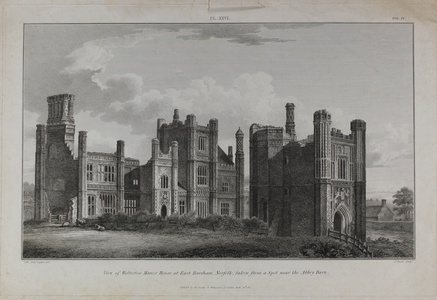| Method | Copper engraving |
| Artist | James Basire after John Adey Repton |
| Published | Publish'd by the Society of Antiquaries of London, April 23rd, 1811. |
| Dimensions | Image 260 x 435 mm, Plate 320 x 480 mm, Sheet 345 x 495 mm |
| Notes |
A view of Wolterton Manor, now East Barsham Manor, from 'Vetusta Monumenta' a series of illustrated antiquarian papers on ancient buildings, sites, and artefacts, mostly of Britain, published at irregular intervals between 1718 and 1906 by the Society of Antiquaries of London. John Adey Repton (1775–1860) was an English architect. James Basire (1730 - 1832) was a British engraver, often confused with his son of the same name. In 1745, Basire was apprenticed to the engraver Richard William Seale and afterwards travelled to Italy with the artist and engraver Roger Dalton. By the 1760s he had established a successful engraving practice. In 1755 Basire was appointed engraver to the Society of Antiquaries and after that time documentary or pictorial antiquarian engraving formed the majority of his work. Basire is best remembered for his 1770 engraving of the historical painting The Field of the Cloth of Gold (c.1550-80) that depicts the festivities following the meeting of Henry VIII with the French King Francis I in 1520. This was the largest engraving ever made and took Basire over two years to complete. Between 1761 and 1783, he exhibited his prints at the Free Society of Artists. Both of his sons, James and Richard Woolett, were apprenticed to him, but more notably, so was William Blake. Condition: Two tears to top sheet edge, toning and foxing to sheet, creasing to corners. |
| Framing | unmounted |
| Price | £80.00 |
| Stock ID | 49026 |

